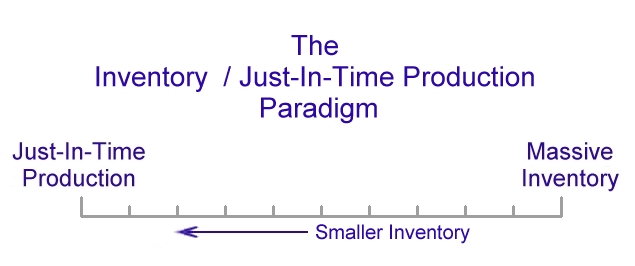Everything you need to know about Just-In-Time inventory can be summarize in a single word: Nothing.
Or perhaps two words: Absolutely Nothing.
Why? Because, although the term “Just-In-Time inventory” has been commonly used for many years, there is no such thing as “Just-In-Time inventory”. “Just-In-Time” refers to the moment of production — just in time — not to inventory. Inventory is a bunch of stuff waiting around to be used. By definition you can’t wait around just in time.
Fortunately the use of “Just-In-Time production” seems to have overtaken the use of JIT inventory in recent years. I’ve watched this as Google search results for the two have, over time, shifted to a dramatically larger number for JIT production (264,000,000 results) than for JIT inventory (109,000,000 results). That’s a good sign, although it’s unfortunate that so many people have believed for so long that Just-In-Time inventory is a concept that somehow makes sense.
There is, however, a relationship between inventory and JIT production. Inventory and JIT production define the opposite ends of a model, or a way of thinking, about this subject. Put a fancy way, inventory and JIT production define opposite ends of a paradigm. At one end of the paradigm is massive inventory — e.g., ocean water on Earth — and on the other end something that simply cannot be effectively inventoried — children’s soap bubbles, for example.
The key to making the concept of JIT production work for you is to understand the needs of each component in the system and keep inventory for that component at the right level, the lowest level possible consistent with the overall needs of the system. All the while we work toward eliminating inventory entirely if possible.
However, we can’t be stupidly dogmatic about it. We are talking about a system, after all. Some parts of the system can’t tolerate inventory at all, and in other parts large inventory may be the lessor of a set of conflicting evils.
Consider, for example, the restaurant business.
Most restaurants have relatively little business on Mondays. Business grows throughout the week, building to a peak on Friday and Saturday nights. A restaurant normally wouldn’t spend slow time on Monday preparing a large inventory of food to be served on Saturday. At least we hope they wouldn’t.
However, a busy pizza restaurant will go through hundreds of pizza boxes during the rushes on Friday and Saturday. Folding a box just-in-time for each pizza probably isn’t very smart. Just-in-time production of boxes would mean the restaurant will either have to hire somebody to fold the boxes just-in-time on Friday and Saturday nights, or have the existing staff take the time to fold a box as each pizza comes out of the oven. This latter case may create a choke point in the production process, reducing the overall production capacity of the kitchen. That makes the customers wait unnecessarily, and is a poor use of capital. None of these is a good option.
The better option, then, is to spend the slow times of the week to build an inventory of boxes. Two facts: 1) Every pizza needs a box, and, 2) the manager has a good estimate of how many pizzas are likely to be sold on Friday and Saturday. Put the two together and we know how large of an inventory of folded boxes must be produced during the week to be prepared for the coming weekend.
The point is that, while we would like to have Just-In-Time production in all cases, JIT production sometimes simply isn’t yet a practical solution. Sometimes a comparatively large inventory does make some sense. But we can’t begin to master this subject if we randomly mix discussions of inventory and Just-In-Time production by talking nonsense about something that doesn’t exist: Just-In-Time inventory.
Copyright 2016 by Paul G. Spring. All rights reserved.


